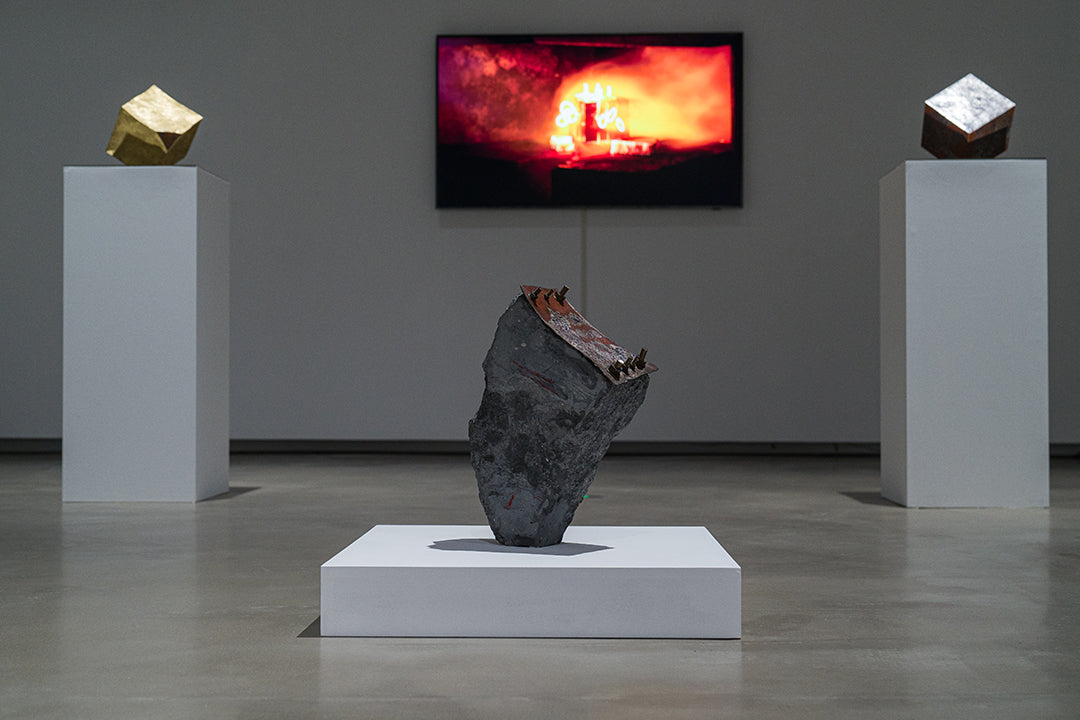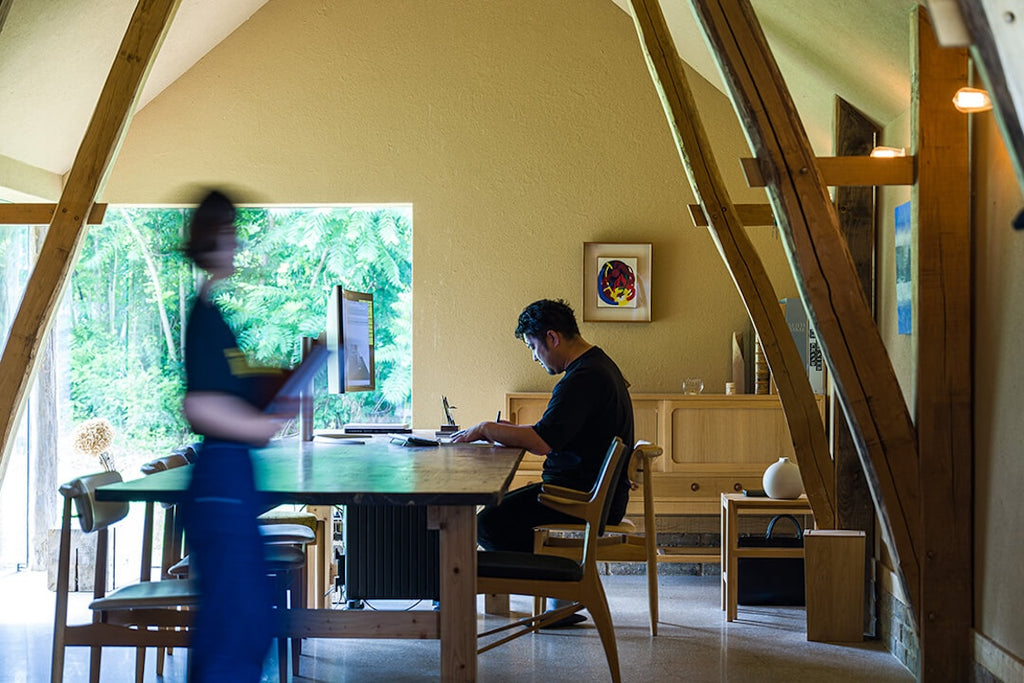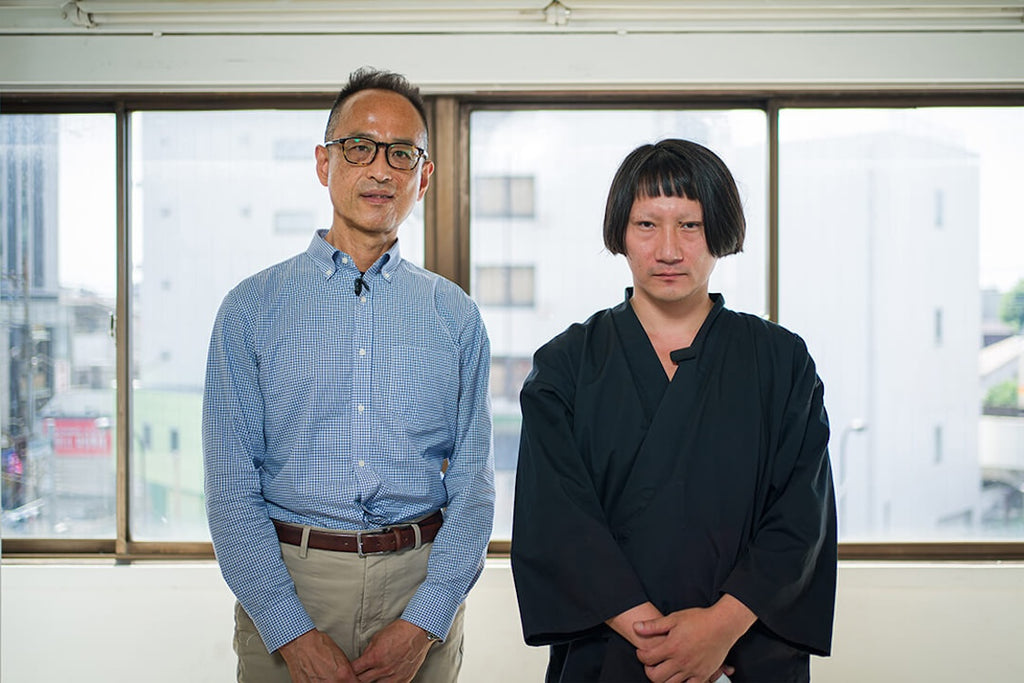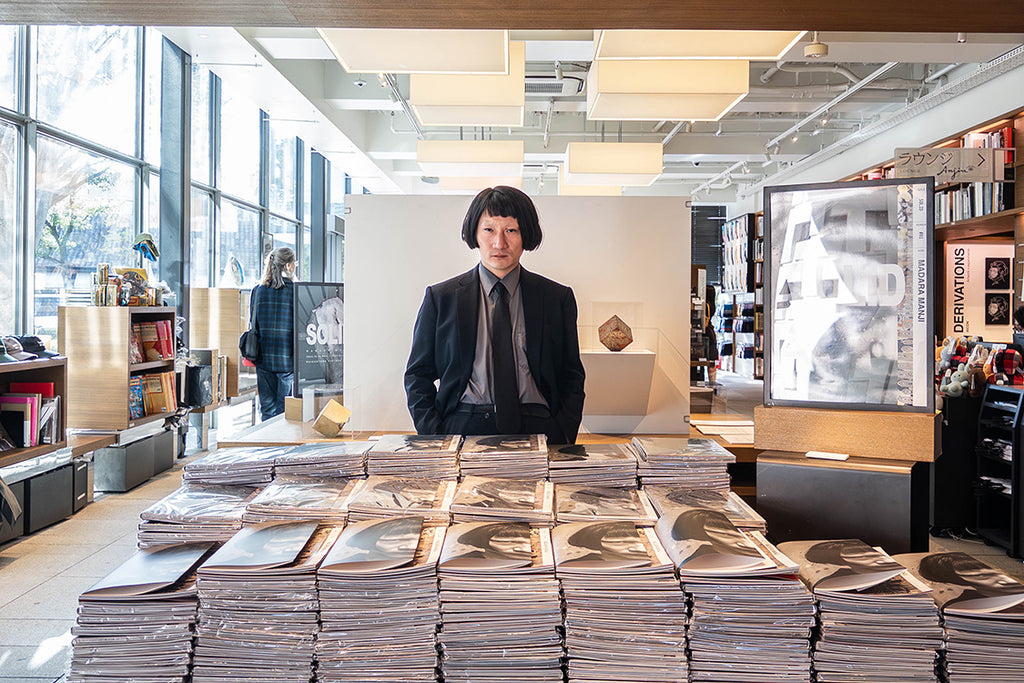ARTICLES
Madara Manji × Meiji Hijikata|The Fusion of Evolving Traditions and Contemporary Art
2024.07.12
INTERVIEW

Meiji Hijikata × Madara Manji
This series of articles features insightful conversations between various artists and Meiji Hijikata, Director of the Taro Okamoto Museum of Art, Kawasaki, as they delve into the essence of their artworks. The sixth installment presents a dialogue with Madara Manji, a contemporary artist renowned for his utilization of the traditional Japanese metalworking technique, "Mokume-gane".
In the first part, Meiji Hijikata visits Madara Manji's art studio to explore the artist's creative process and the underlying themes of his work. In this second part, Manji reflects on his artistic journey, tracing it back to his childhood. The conversation also uncovers the parallels between Manji and Taro Okamoto, a luminary who has made an indelible impact on the history of Japanese art.
Madara Manji: A Name that Represents His Being

“Invisible Dimension” 2024, Whitestone Gallery Beijing
Hijikata: First off, I want to ask you about your name. I think "Madara Manji" is an unusual name. Where did it come from?
Manji: There are various reasons why people have the names they do, but typically, a person's name is given by their parents rather than chosen by themselves. My birth name was given to me by my parents, but I often wondered about the possibility of selecting my own name. When I embarked on my career as an artist, I decided to adopt a name of my choosing.
If you alter my real name slightly, you get "Manji." I then chose the name "Madara Manji," inspired by the Japanese word "Madara," which describes the mottled patterns present in my artworks.
Doubts About Human Society Turn into Curiosity About Humanity

Madara Manji
Hijikata: What made you decide to become an artist in the first place? Were you interested in creating things from a young age?
Manji: Actually, I hated making things (laughs). I was born in Tokyo in 1988, and I was surrounded by ready-made products all my life. I disliked creating things because I didn't have the resilience needed for it. I even started skipping school as early as kindergarten.
Hijikata: Kindergarten is a very early age to become truant.
Manji: What surprised me in kindergarten was the abundance of human constructs that I could not see. For example, it started with basic things like having to eat meals using utensils. Then there were things like morals, rules, schedules, and history, and I felt stressed because I could not understand why they were necessary. So after the first day of kindergarten, I decided to stay home and spend my days there.
While spending time at home, I began to wonder about the things that humans have while other animals do not, and I reached a state of doubt. Then I realized that this "doubt" might be rooted in "imagination". Of course, I could not articulate it like this back then, but the "humanity" that I once found incomprehensible had suddenly become something interesting.
I started wondering what’s left when you take away the animal side of being human, which got me interested in psychology and philosophy. I wanted to express those ideas in a tangible way. In my mid-teens, I discovered art as a genre and thought it could be the perfect way to do that. That’s when I decided to become an artist.
Similarities Between Taro Okamoto and Madara Manji

Meiji Hijikata
Hijikata: Having difficulty integrating into everyday social life as a child was also true for Taro Okamoto.
Taro Okamoto was the child of Ippei Okamoto, a pioneer of Japanese satirical cartoons, and Kanoko Okamoto, a writer and poet. Taro entered primary school without having learned any social norms, and as you would expect, he could not fit in at all.
When he was around 19 or 20 years old, he went to Paris with his parents, and in his early twenties, he joined an international art group that promoted abstract art, before moving towards the Surrealism movement. As an artist, he became a young star in his own right, but he also began to have significant doubts about art itself. Both groups aimed to liberate the suppressed aspects of human beings to create new forms of art, but ultimately, the art remained inaccessible to the general public.
In his mid-twenties, he fell into a slump, and just like yourself, he developed an interest in disciplines outside of art such as philosophy, psychology, and religion, ultimately arriving at ethnography. Okamoto was the first one who found artistic significance in Jomon pottery. It was through his knowledge of religion and ethnography that he was able to understand art that is outside the context of Western art.
What I want to say is that questioning everything, even things that are considered common sense, during one's most impressionable years is proof of having a very important kind of sensibility as an artist. Artists should question common sense and social norms when they are young. Instead of avoiding it entirely, being able to create artworks or something that can serve as a catalyst for change is a crucial point in an artist's career.
Holding an Exhibition with a Single Artwork at 29 Years

“Invisible Dimension” 2024, Whitestone Gallery Beijing
Hijikata: Tell me about the path you took before debuting as an artist.
Manji: The first theme I thought about was "What is a person?" I broke this down into various elements and started by exploring "what is the state of the human mind" to visualize the order and chaos within the human psyche.
I wanted to combine different metals to create iconic works, but I had no clear idea how to do it. After researching various methods, I decided to apprentice under a master craftsman in a traditional metalworking shop in Kyoto. For about two years, I learned basic metalworking techniques such as hammering, heating, filing, polishing, finishing, and welding. Then, at 22, I left that industry.
After that, I immersed myself in my own world, living as I pleased without working for nearly ten years until my late twenties. When I finally decided to create artworks, I quickly realized the simple and obvious fact that creating art requires money. Without artworks, I couldn't hold exhibitions, and without exhibitions, I couldn't earn any income from my art.
So, for the first time, I changed my mindset and started working part-time. At 29, after working part-time for a year, I managed to create just one artwork. Whitestone Gallery saw my work and decided to scout me.
Hijikata: Where did this happen?
Manji: The opportunity came during an exhibition where I showcased just that one piece. I displayed it right here (where we're having this conversation), but over the week, fewer than twenty people visited. However, through one of those visitors, I got in touch with Whitestone Gallery. From that point on, instead of just thinking and imagining, I became much more active in using my hands to create art.

“Invisible Dimension” 2024, Whitestone Gallery Beijing
Hijikata: How long ago was your first exhibition with Whitestone Gallery?
Manji: The first one was back in 2017.
Hijikata: How many artworks did you exhibit at that time?
Manji: Eleven pieces.
Hijikata: And how was the response to it?
Manji: It was such a failure that I thought I would get sacked. But after being given this opportunity, I wanted to move my career forward somehow. I got the ball rolling and got a chance to do another exhibition. Whether I could produce results or not was the key to the next step, so I kept on delivering which led me to get more work, and this has brought me to where I am now.
Hijikata:That you were able to keep doing it probably meant that there was a certain level of satisfaction with your work, and the response had gotten better.
Manji: Yes, little by little.

MADARA MANJI: Antagonism and Transcendence, Whitestone Gallery Karuizawa Gallery, 2017
The Future Envisioned by Madara Manji as an Artist

“Invisible Dimension” 2024, Whitestone Gallery Beijing
Hijikata: Do you plan to do any exhibitions this year?
Manji: Yes. This year, I am focusing on holding exhibitions in art museums, as well as doing research. Up until now, I have focused all my efforts on the art market. It has been a period where I poured out the power inside myself, taking the thoughts and feelings I continuously had every day over 10 or 20 years as an input, and expressing it in some form of output.
However, I was so focused on creating artworks that I did not find the time to think of new approaches or envision the future of my art. For my current Cube series, throughout my twenties, I was able to create only one piece that could be called a work of art. But over the next four or five years, I made around 130 pieces, and they have become something I am satisfied with technically. While I feel happy that all my works have been sold, I was left baffled when somebody asked me what other forms of artistic expression I had.
To break myself out of that situation, I realized that I should create outputs that can express my worldview more clearly and on a grander scale, so I decided to shift my focus to doing research and art museum exhibitions. This was around two years ago. My highlight in 2024 is a solo exhibition at the Shiga Kogen Roman Museum in Nagano Prefecture. The museum is housed in a building designed by Kisho Kurokawa, which I feel is a great match for my artworks.
I also want to take on the challenge of creating large-scale art objects similar to land art.
Hijikata: Can you be more specific?
Manji: Mokume-gane is a technique for creating small objects, but I believe that there are common points between the smallest and largest creations. An example would be the idea that genetics and the universe are structurally similar. I like this idea that there is something in common even if the size is on a different scale, which is why I am planning to do public art projects. I am currently looking for assistants and assembling a team to help me achieve this goal.
Hijikata: So it seems that you have decided on a clear direction for yourself.
Manji: I still have a long way to go, but I am where I am today thanks to the support and guidance of many people.
Art Objects that Connect Craftsmanship and Art

“Invisible Dimension” 2024, Whitestone Gallery Beijing
Hijikata: In recent years, the distinction between craftsmanship and contemporary art has become increasingly blurred.
The term "objet" (art object, from the French "objet d'art") gained popularity in postwar Japan. Its meaning can vary depending on the context, often associated with sacred or ceremonial items in indigenous art. Depending on one's perspective, an objet can be seen as a fetish, something imbued with sensory or supernatural significance.
For instance, if you aim to establish yourself as a contemporary artist abroad, it's crucial to embody not only individual uniqueness but also a global perspective and international appeal. What I'm emphasizing is that in your exploration of art objects, the traditional Japanese metalworking technique of Mokume-gane, passed down by our predecessors, can be a tremendously valuable asset, distinct from Western traditions. It will be fascinating to see how you integrate it into your repertoire and present it going forward.
Manji: Yes.

Meiji Hijikata × Madara Manji
Artworks forged with the intense energy of heat exceeding 1000°C and countless hammer strikes record elements deeply significant to Madara Manji. Through this rigorous creation process, he infuses his works not only with visual beauty but also with inner spirituality and profound philosophy.
Reimagining the traditional Japanese technique of Mokume-gane in a contemporary context, Madara Manji constructs a unique artistic realm that offers fresh perspectives and evokes deep emotions in viewers. He harbors a fervent ambition to expand his artistic horizons through ambitious projects such as museum exhibitions and large-scale land art.
To view all of MADARA MANJI's artworks, click here .



